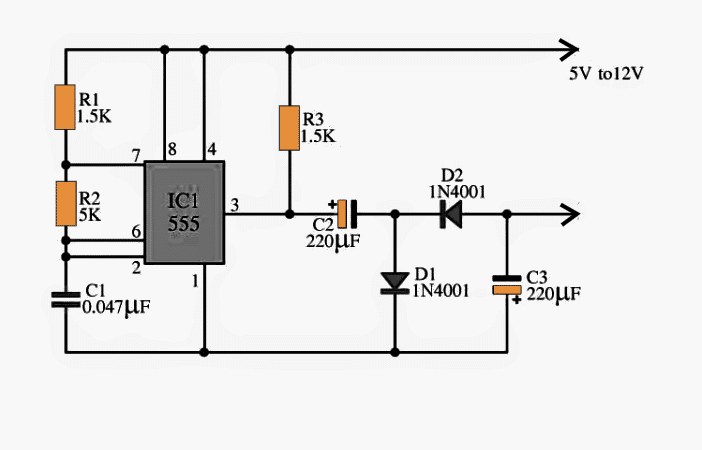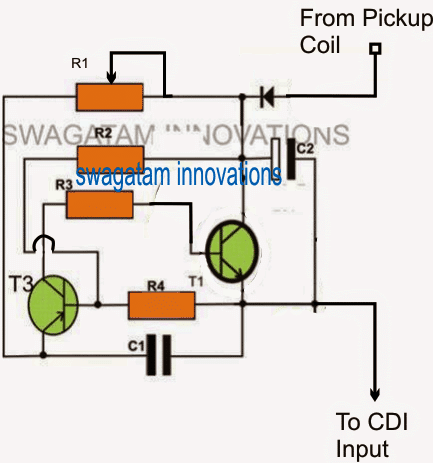The post investigates a simple 2 pin oscillator circuit which may be inserted between the pickup coil and the CDI unit of a vehicle for achieving an induced multi trigger input in response to each signal from the pickup coil coil, this in turn is expected to enhance the sparking ability of the CDI coil. The idea was requested by Mr. Vimal.
Technical Specifications
Thank you for your help on the 555 buck boost circuit.
Needed your help with one more circuit concept.
Please note the details as below.
1) In a petrol engine vehicle, the sparking is done due to an ignition coil. This coil is driven on 12 volts pure dc.
2) In some experiments it was noticed that if the coil is supplied with pulsed dc at a certain frequency, the sparks become stronger due to the coil operating at its optimum resonant frequency without requiring an actual increase in operating input voltage or even bigger amperage draw.
3) Increasing input voltage from 12 volts to higher voltages would also increase the spark intensity, but this would lead to damage of the primary coil in the long run. Also as the primary coil would heat up more due to higher voltage, it would draw more amps eventually leading to coil failure.
4) I wanted your help in designing a circuit which is a passive dc to variable pulse dc converter, and does not require any ground connection to operate.
The criteria of "NO GROUND CONNECTION" is due to the fact, that the circuit should fix in series on the +ve input line of the coil as it is not possible to modify the original harness of the vehicle to change coil connections.
(+DC voltage IN and Pulsed DC voltage OUT fed directly only on the + live line connecting to the +ve terminal of the coil).
5) The total amp draw of a regular ignition coil usually does not exceed 15 amps. Hence this circuit should be able to handle 15 amps of power draw passing through it.
6) An increase of 1 - 2 volts above the input voltage is acceptable.
7) I found a circuit online which does not require an external ground to operate. I do not understand the deep working of electronics, hence I am attaching it herewith for your reference. I am not sure if this design would work for the application that I have in mind.

8) The reason behind having a variable frequency control on this circuit is that we can have a test bench setup to study the best resonant frequency at which automotive coils would operate without any damage.
I would really appreciate it if you could help me with the design and concepts of this kind of circuit.
Please note that the attached circuit is for your reference. The actual circuit design required can be different, so please feel free to offer your kind advice if the required end results could be achieved by using different principles and circuit design.
P.S. :- Sorry for not posting this on your blog, as I did not want to flood your blog with my outlandish ideas.
Thanks for your time and support.
Vimal Mehta
The Design
The attached circuit above might work if its 12V terminal is connected with the vehicle's +12V battery and the output from pin#3 to the pickup coil. This would enable breaking of the pickup signal into many short pulses, however the idea does not appear to be an efficient approach, since this would reduce the CDI triggering time to some lower level and in turn might cause a drop in the intensity of the generated sparks.
Any other more efficient configuration doesn't look feasible with the above the design.
The requested multi spark induction into an existing CDI ignition system may be achieved with the help of the following explained circuit:

The circuit actually is inspired from a two pin automobile flasher circuit invented by me a long time ago.
The circuit actually oscillates in a regenerative kind of fashion, where the two transistors complement each other to turn ON fully and turn OFF fully at a set frequency.
You may also want to refer to the following related articles for more info:
Adjustabe CDI Spark Advance/Retard Circuit for Motorcycles
Universal Multi-spark Enhanced CDI Circuit for Automobiles
The frequency is determined by R1 and C1, any of these components can be altered for achieving the desired oscillations across the output terminals.
For the proposed multi spark variable frequency CDI ignition, the above circuit can be connected in series with the pick-up signal wire as illustrated in the diagram.
The voltage from each pulse is stored inside C2 for some extended limit of time, during which the circuit quickly delivers a number of short pulses, at a frequency determined by the C1, R1 combination.
R2, and R3 also influence the oscillation rates but these might also influence the pulse width of the output, and can be optimized some for getting the right amount of PWM, and a most effective response from the CDI coil.
Parts List
R1 = 100k preset
R2, R3 = 10K,
R4 = 33K,
T1 = TIP122
T3 = BC557,
C1 = 0.33uF/25V
C2 = 100uF/25V (other values can be tried)
D1 = 1n4007,